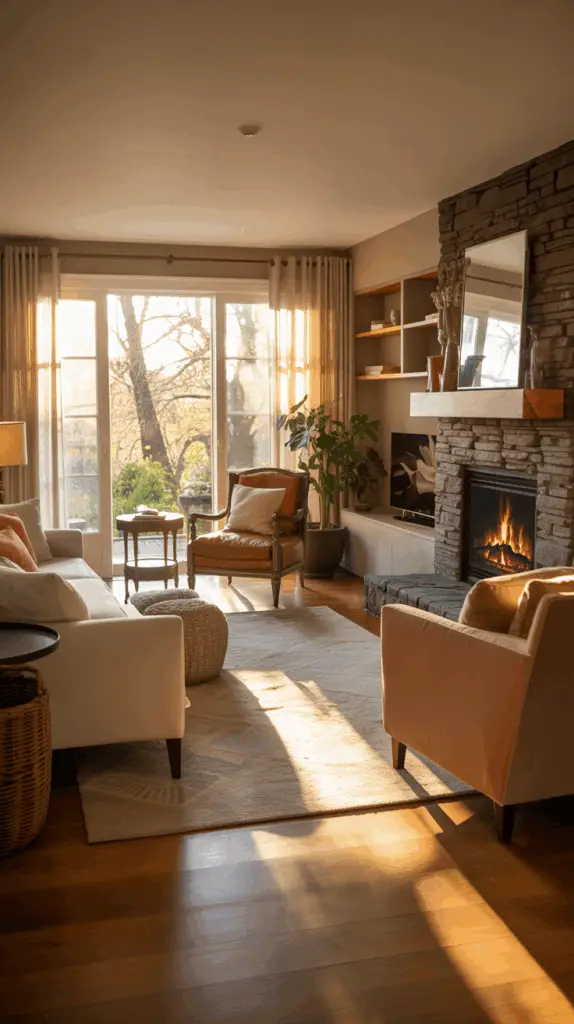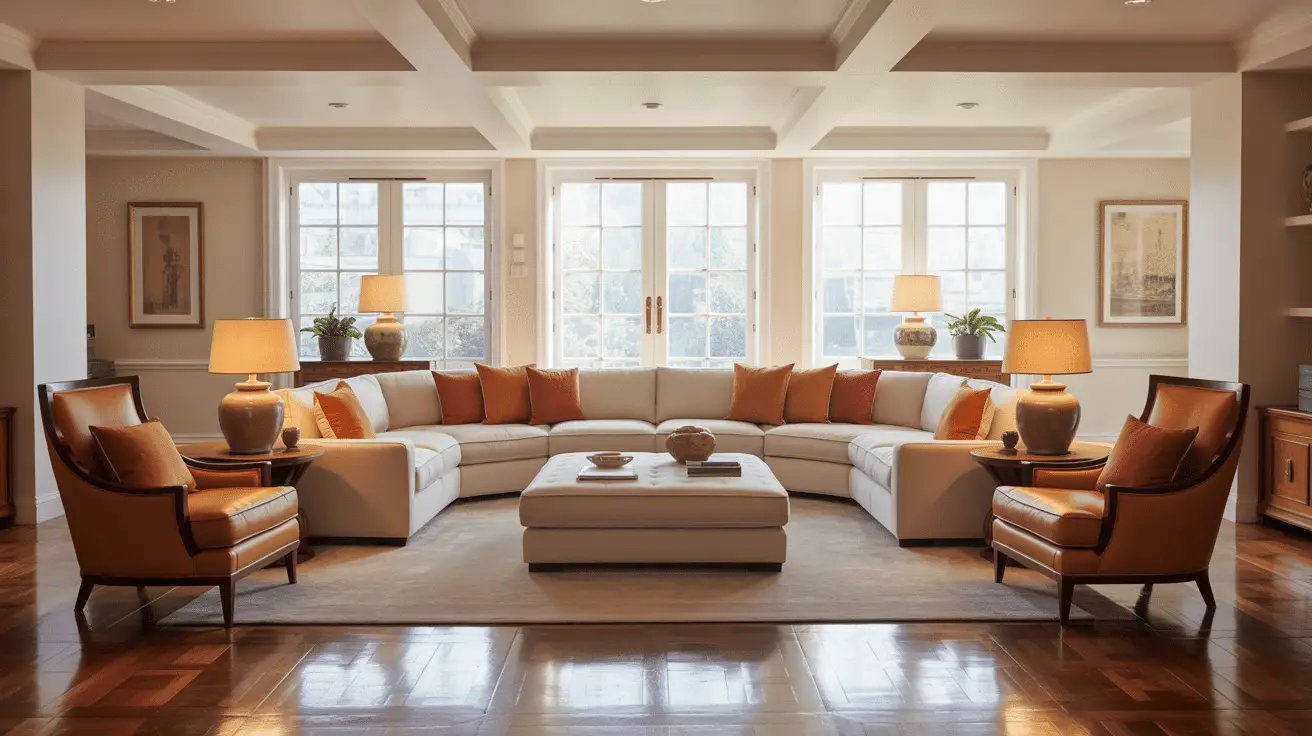How to Arrange Furniture in a Large Living Room for Optimal Flow and Comfort
Table of Contents
Introduction:
Arranging furniture in a large living room can be a daunting task. Unlike smaller spaces where every piece must serve multiple purposes to make the most of limited square footage, large rooms offer plenty of opportunities to get creative. However, without careful planning, a large living room can feel disjointed or overcrowded, failing to create the comfortable, cohesive space you envision.
The goal when arranging furniture in a large living room is to maintain a sense of balance and flow while making the room feel inviting and functional. It’s about creating a layout that promotes easy movement, enhances comfort, and highlights the best features of the space. Whether you have a formal space for entertaining or a casual area for family gatherings, knowing how to arrange furniture for optimal flow can help transform your living room into a harmonious environment that serves both style and function.
In this guide, we’ll walk you through practical tips and strategies for arranging furniture in a large living room. From zoning the space to choosing the right furniture pieces, these ideas will ensure your living room layout maximizes its potential, offering both comfort and aesthetic appeal.
1. Understand the Space and Plan Your Layout
The first step in arranging furniture in a large living room is understanding the space and its dimensions. Large rooms can be tricky because they often have multiple zones that need to be defined. Before moving anything around, take time to measure the room and visualize where the furniture will go. This will help you create a floor plan that maximizes the space’s potential while maintaining a natural flow.
Start by identifying key areas within the room, such as a conversation area, entertainment center, and reading nook. Use rugs, lighting, and furniture to establish boundaries between these zones. It’s important to ensure there’s enough space for people to move around comfortably, so avoid blocking walkways or doorways with large pieces of furniture.
Use a floor plan tool or sketch out a few ideas on paper before committing to a layout. This will allow you to experiment with different configurations and see what works best. Pay attention to the focal points of the room, like windows, fireplaces, or TV units, and arrange furniture around them for an aesthetically pleasing and functional setup.
2. Create Flow by Using Furniture as Anchors
In large living rooms, furniture plays a critical role in establishing flow. By using key furniture pieces as anchors, you can create a sense of structure that guides movement and maintains an open, breathable space. The primary pieces of furniture in the room—such as a sofa, armchairs, or a coffee table—serve as the foundation for the rest of the layout.
Position the largest piece of furniture, like the sofa, in a way that naturally divides the room into smaller, functional zones. In a rectangular space, for example, you might place the sofa along one of the longer walls, with seating areas or additional pieces forming a parallel layout. Avoid placing large furniture pieces against the walls, as this can make the space feel disconnected. Instead, try to create an inviting, conversational layout by arranging furniture closer to the center of the room.
Once the main furniture pieces are in place, add complementary items, such as side tables, lamps, and rugs, to enhance the flow and bring the room together. Consider the height and scale of furniture to ensure a balanced look and avoid overcrowding any one area of the room.

3. Use Rugs to Define Zones and Add Warmth
Rugs are an essential tool for defining zones within a large living room. In open-plan spaces, a rug can help create a visual boundary between the different functional areas, such as the seating area, the entertainment area, or a reading nook. When selecting rugs, choose sizes that complement the space—too small, and the rug will look out of place; too large, and it can overwhelm the room.
For a harmonious design, place the rug beneath the central seating area so that it anchors the furniture. This will help to create a cohesive, grounded look and prevent the space from feeling disjointed. Additionally, using multiple smaller rugs in different zones can introduce texture and warmth, making the room feel more inviting.
Rugs also play a role in sound absorption, which can be beneficial in large living rooms with high ceilings or hard floors. A thick, plush rug will not only define the space visually but also add comfort underfoot.
4. Focus on Focal Points to Guide Furniture Placement
Every room has focal points—features that naturally draw the eye. In a large living room, these might include a fireplace, large windows with a beautiful view, or an entertainment center. When arranging furniture, it’s essential to align seating areas with these focal points to create a harmonious flow. This positioning ensures that the space feels balanced and visually appealing.
Start by identifying your room’s natural focal point. If you have a fireplace, arrange the seating around it to encourage conversation and create a cozy atmosphere. If your living room boasts large windows or a spectacular view, arrange the furniture to highlight that feature. Similarly, if the TV is the focal point, center the seating to face the screen without overwhelming the room with oversized furniture.
By placing furniture in alignment with your room’s focal point, you create a natural flow that allows the space to feel balanced and inviting. Avoid pushing all the furniture against the walls, which can create a disjointed layout and disrupt the room’s flow.
5. Consider Traffic Flow and Pathways
In large living rooms, traffic flow is an essential aspect of furniture arrangement. People should be able to move freely from one area to another without obstacles. When planning the layout, be mindful of how people will move through the room. Ensure there are clear pathways between furniture pieces, especially if the room has multiple zones.
Avoid placing large pieces of furniture directly in the path of foot traffic. Instead, leave enough space between furniture pieces to allow for easy movement. A common rule of thumb is to allow at least 24 inches of walking space around furniture. If possible, create paths that naturally guide movement through the room, such as between seating areas or around coffee tables.
When planning the flow, also consider the layout’s functionality. For example, in a living room where guests will be entertained, ensure that the space is easy to navigate so that people can move between conversation areas and refreshments without feeling cramped.
6. Use Vertical Space to Balance Large Rooms
In large living rooms, it’s essential to balance not only the horizontal layout but also the vertical space. High ceilings can create an overwhelming feeling of emptiness, so using the vertical plane effectively can bring the room together. Consider adding tall furniture pieces, like bookshelves, floor lamps, or large art pieces, to fill the vertical space and add a sense of balance to the room.
Another option is to use hanging light fixtures or pendant lights to draw attention upward. Vertical elements help balance the room’s proportions and make the space feel more cohesive. Avoid overcrowding the room with too many large pieces—instead, focus on one or two statement items that enhance the overall flow.
Conclusion
Arranging furniture in a large living room for optimal flow is all about creating a space that feels cohesive, functional, and inviting. By focusing on key principles such as zoning the room, anchoring furniture, using rugs to define spaces, and considering traffic flow, you can transform your living room into a beautifully arranged space that promotes comfort and relaxation. With careful planning and attention to detail, your large living room will become the perfect setting for both everyday living and entertaining.

